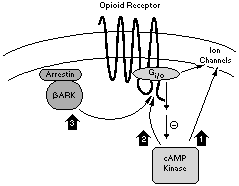
Scheme illustrating possible mechanisms of opiate tolerance in the LC. Chronic opiate administration produces tolerance--a relative decrease in the ability of m opiate agonists to regulate K+ channels and a Na+-dependent inward current in LC neurons. Although the mechanisms underlying tolerance have not yet been established, three types of mechanisms are proposed. Arrow 1: The up-regulated cAMP system in the LC would contribute to tolerance by making it more difficult for opiates to acutely inhibit the Na+-dependent inward current via inhibition of the cAMP system. Arrow 2: It is possible that the up-regulated cAMP system also contributes to tolerance in LC neurons by enhancing desensitization of the m-opioid receptor. This is based on the observation that the cAMP pathway promotes desensitization of the receptor (possibly via receptor phosphorylation) induced by short-term enkephalin exposure under control conditions. This mechanism is consistent with the ability of cAMP-dependent protein kinase to phosphorylate and desensitize other G-protein-linked receptors. Arrow 3: Based on the evidence that several G-protein-linked receptors are also phosphorylated and desensitized by bARK and associated proteins (e.g., b-arrestin), it is possible that the chronic morphine-induced increase in bARK levels in LC neurons contributes to opiate tolerance. From 40.